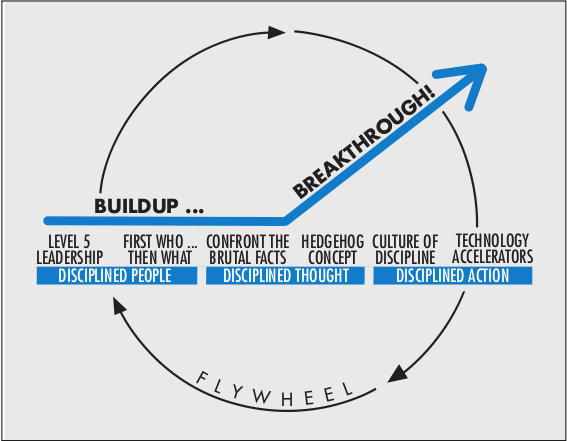The second stage of Collins ‘Good to Great’ Transformation process talks about the type of thinking great leaders adopted to get their organizations from smallness to significance.
Transformation of a company, business or organization from a point of break-even to a point where it achieves market relevance is the dream of every leader. However, this is easier said than done. In his Book ‘Good to Great’, Jim Collins provided a framework for achieving company transformation using the flywheel concept. This was created after Collins studied 28 companies, 11 of which successfully made the leap from ‘Good to Great’.
Collins identified four company transformation stages;
- Disciplined People
- Disciplined Thought
- Disciplined Action
- Building Greatness to Last
Disciplined Thought
 Confront the Brutal Facts
Confront the Brutal Facts
This is the stage where, as a leader, you lay all your cards on the table and deal with the realities of the situation – good or bad. At this stage, there is no use sugarcoating or dressing the facts. According to Collins, great leaders understand the importance of this stage and show discipline in assessing the situation. However, they also showed hope, thought of possible solutions and were ready to get out of their comfort zones to put things back on track.
A good leader understands what must be done, gets things done using the right tools (dialogue, teamwork, delegation, trust) and shows resolve in the face of challenges but a poor leader would rather stay put in his comfort zone and pass the buck of blame about. He is never guilty and would rather find the easy way out. This is a distinguishing factor between leaders that made the leap to greatness and leaders that kept their organizations on the average mark.
Hedgehog Concept
The hedgehog concept is really about one thing; simplicity. It takes all the information, ideas and opinions, processes and synthesizes it to create something easy, simple, basic and understandable. This concept helps guide and form the organizational goal and direction and everything is built around this founding, basic idea. Collins believed that great leaders achieved success by finding the intersecting point of the answer to these three questions;
- What were they deeply passionate about?
- What could their organizations be the best at?
- What was the motivating economic factor for their organizations?
With these, they were able to gain insight into what the organization stood for, where its strength lay and where the real vantage point was. Then, they built the brand around this core idea and stuck with it (adding only critically important tweaks without sharply diverting from the core mission and vision)

No Comments